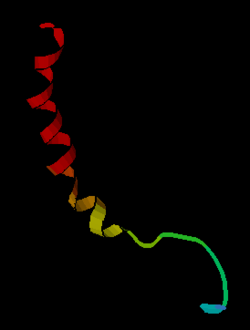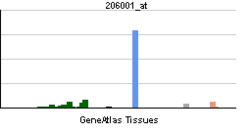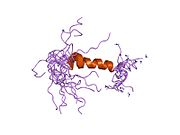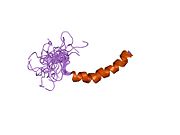- Neuropeptide Y
-
Neuropeptide Y (NPY) is a 36-amino acid peptide neurotransmitter found in the brain and autonomic nervous system.
Neuropeptide Y Clinical data Pregnancy cat. ? Legal status ? Identifiers ATC code ? ChEMBL CHEMBL267633 
Chemical data Formula C190 H287 N55 O57 Mol. mass 4253.6  (what is this?) (verify)
(what is this?) (verify)
"NPY has been associated with a number of physiologic processes in the brain, including the regulation of energy balance, memory and learning, and epilepsy."[1] The main effect is increased food intake and decreased physical activity. NPY is secreted by the hypothalamus, and, in addition to increasing food intake, it increases the proportion of energy stored as fat and blocks nociceptive signals to the brain.[2] NPY also augments the vasoconstrictor effects of noradrenergic neurons.Contents
Discovery
Following the isolation of neuropeptide-y (NPY) from the porcine hypothalamus in 1982, researchers began to speculate about the involvement of NPY in hypothalamic-mediated functions.[citation needed] Among these hallmark studies was a study done by Allen et al. in 1983.[3] One of the major findings in this study was the location of NPYergic axon terminals in the paraventricular nucleus (PVN) of the hypothalamus. Moreover, Allen et al. discovered the highest levels of NPY immunoreactivity within the PVN of the hypothalamus.[3]
Six years later, in 1989, Morris et al. homed in on the location of NPYergic nuclei in the brain. Furthermore, in situ hybridization results from the study showed the highest cellular levels of NPY mRNA in the arcuate nucleus (ARC) of the hypothalamus.[4]
However, just two years earlier, in 1987, Haas & George conducted a study that involved injecting NPY locally and discovered an interesting result: local injection of NPY into the PVN resulted in an acute release of corticotropin-releasing hormone (CRH) in the rat brain, proving that NPYergic activity directly stimulates the release and synthesis of CRH.[5]
The latter became a hallmark paper in NPY studies. A significant amount of work had already been done in the 1970s on CRH and its involvement in stress and eating disorders such as obesity.[6] These studies, collectively, marked the beginning of the role of NPY in orexigenesis or food intake.
The role of NPY in food intake
Behaviorial assays in orexigenic studies, in which rats are the model organism, have been done collectively with immunoassays and in situ hybridization studies to confirm that NPYergic activity does indeed increase food intake. In these studies, exogenous NPY,[7] an NPY agonist such as dexamethasone[8] or N-acetyl [Leu 28, Leu31] NPY (24-36)[9] are injected into the third ventricle[7] or at the level of the hypothalamus with a cannula.[8][10]
Furthermore, these studies unanimously demonstrate that the stimulation of NPYergic activity via the administration of certain NPY agonists increases food intake compared to baseline data in rats. The effects of NPYergic activity on food intake is also demonstrated by the blockade of certain NPY receptors (Y1 and Y5 receptors), which, as was expected, inhibited NPYergic activity; thus, decreases food intake. However, a 1999 study by King et al. demonstrated the effects of the activation of the NPY autoreceptor Y2, which has been shown to inhibit the release of NPY and thus acts to regulate food intake upon its activation.[11] In this study a highly selective Y2 antagonist, BIIE0246 was administered locally into the ARC. Radioimmunoassay data, following the injection of BIIE0246, shows a significant increase in NPY release compared to the control group. Though the pharmacological half-life of exogenous NPY, other agonists, and antagonist is still obscure, the effects are not long lasting and the rat body employs an excellent ability to regulate and normalize abnormal NPY levels and therefore food consumption.[7]
The role of NPY in obesity
Dryden et al., conducted a study in 1995 using genetically obese rats to demonstrate the role of NPY in eating disorders such as obesity. The study revealed four underlying factors that contributed to obesity in rats: (1) an increase in glucocorticosteroid concentrations in plasma; (2) insensitivity or resistance to insulin; (3) mutation of leptin receptor; and (4) an increase in NPY mRNA and NPY release.[12] Furthermore, these factors also correlate with each other. The sustained high levels of glucocorticosteroids stimulate gluconeogenesis, which subsequently causes an increase of blood glucose that activates the release of insulin to regulate glucose levels by causing its reuptake and storage as glycogen in the various tissues in the body. In the case of obesity, which researchers speculate to have a strong genetic and a dietary basis, insulin resistance prevents high blood glucose regulation, resulting in morbid levels of glucose and diabetes mellitus.[13] Furthermore, high levels of glucocorticosteriods causes an increase of NPY by directly activating type II glucocorticosteriods receptors (which are activated only by relatively high levels of glucocorticosteriods) and, indirectly, by abolishing the negative feedback of CRF on NPY synthesis and release. Meanwhile, obesity-induced insulin resistance and the mutation of the leptin receptor (ObRb) results in the abolition of other negative feedback mechanisms to regulate NPYergic activity and ultimately food intake. Furthermore, obesity in rats was significantly reduced by adrenalectomy[14] or hypophysectomy.[15]
The role of NPY in anorexia nervosa
Kaye et al. conducted a study in 1990 to demonstrate the role of NPY in anorexia nervosa. In this post mortem study, high levels of NPY were found in the cerebrospinal fluid of patients with anorexia nervosa. Subsequently, high concentrations of adrenocorticotropic hormone (ACTH) and cortisol in the plasma were also found in patients with anorexia nervosa.[16] Another study conducted seven years later revealed low levels of leptin, the hormone that inhibits NPY release at relatively high levels, were found to correlate with the extremely low levels of adipocytes in these patients; hence, the anorexigenic nature of leptin.[17] Furthermore, while the high levels of NPY increased food intake or hunger in patients with anorexia nervosa, the emotional discomfort associated with eating may explain the resistance to the orexigenic effects of NPY—suggesting a strong limbic system influence on food intake in eating disorder such as anorexia nervosa and bulimia nervosa.[16]
Correlation with stress and diet
Studies of mice and monkeys show that repeated stress — and a high-fat, high-sugar diet — stimulate the release of neuropeptide Y, causing fat to build up in the abdomen. Researchers believe that by manipulating levels of the appetite hormone, they could make fat melt from areas where it was not desired and accumulate at sites where it is needed.[18][19]
Higher levels of NPY may be associated with resilience against and recovery from posttraumatic stress disorder [20] and with dampening the fear response, allowing individuals to perform better under extreme stress.[21]
Receptors
The receptor protein that NPY operates on is a G protein-coupled receptor in the rhodopsin like GPCR family. These receptors are metabotropic, causing metabolic changes in the target cell rather than directly opening ion channels. The protein contains seven membrane-spanning domains and five subtypes have been identified in mammals, four of which are functional in humans.[22] Subtypes Y1 and Y5 have known roles in the stimulation of feeding while Y2 and Y4 seem to have roles in appetite inhibition (satiety). Some of these receptors are among the most highly conserved neuropeptide receptors.
See also
References
- ^ Colmers WF, El Bahn B (2003). "Neuropeptide Y and Epilepsy". Epilepsy Currents/American Epilepsy Society 2 (3): 53–8. doi:10.1046/j.1535-7597.2003.03208.x. PMC 321170. PMID 15309085. http://www.pubmedcentral.nih.gov/articlerender.fcgi?tool=pmcentrez&artid=321170.
- ^ Kimball JW (May 2008-05-02). "Neuropeptide Y (NPY)". Kimball's Biology Pages: Hormones of the Gut. http://users.rcn.com/jkimball.ma.ultranet/BiologyPages/G/GutHormones.html#neuropeptideY.
- ^ a b Allen, YS; Adrian TE, Allen JM, Tatemoto K, Crow TJ, Bloom SR, Polak JM. (1983). "Neuropeptide Y distribution in the rat brain". Science 221 (4613): 877–879. doi:10.1126/science.6136091. PMID 6136091.
- ^ Morris, BJ. (1989). "Neuronal localisation of neuropeptide Y gene expression in the rat brain". J Comp Neurol 290 (3): 358–368. doi:10.1002/cne.902900305. PMID 2592617.
- ^ Haas, DA; George SR. (1989). "Neuropeptide Y-induced effects on hypothalamic corticotropin-releasing factor content and release are dependent on noradrenergic/adrenergic neurotransmission". Brain Research 498 (2): 333–338. doi:10.1016/0006-8993(89)91112-8. PMID 2551461.
- ^ Edwardson, JA; Hough CA. (1975). "The pituitary-adrenal system of the genetically obese (ob/ob) mouse". J Endocrinol 65 (1): 99–107. doi:10.1677/joe.0.0650099. PMID 167093.
- ^ a b c Hanson ES, Dallman MF (April 1995). "Neuropeptide Y (NPY) may integrate responses of hypothalamic feeding systems and the hypothalamo-pituitary-adrenal axis". J. Neuroendocrinol. 7 (4): 273–9. doi:10.1111/j.1365-2826.1995.tb00757.x. PMID 7647769.
- ^ a b White BD, Dean RG, Edwards GL, Martin RJ (May 1994). "Type II corticosteroid receptor stimulation increases NPY gene expression in basomedial hypothalamus of rats". Am. J. Physiol. 266 (5 Pt 2): R1523–9. PMID 8203629. http://ajpregu.physiology.org/cgi/pmidlookup?view=reprint&pmid=8203629.
- ^ King PJ, Widdowson PS, Doods HN, Williams G (August 1999). "Regulation of neuropeptide Y release by neuropeptide Y receptor ligands and calcium channel antagonists in hypothalamic slices". J. Neurochem. 73 (2): 641–6. doi:10.1046/j.1471-4159.1999.0730641.x. PMID 10428060.
- ^ Pomonis JD, Levine AS, Billington CJ (1 July 1997). "Interaction of the hypothalamic paraventricular nucleus and central nucleus of the amygdala in naloxone blockade of neuropeptide Y-induced feeding revealed by c-fos expression". J. Neurosci. 17 (13): 5175–82. PMID 9185555. http://www.jneurosci.org/cgi/pmidlookup?view=long&pmid=9185555.
- ^ King PJ, Williams G, Doods H, Widdowson PS (May 2000). "Effect of a selective neuropeptide Y Y(2) receptor antagonist, BIIE0246 on neuropeptide Y release". Eur. J. Pharmacol. 396 (1): R1–3. doi:10.1016/S0014-2999(00)00230-2. PMID 10822055. http://linkinghub.elsevier.com/retrieve/pii/S0014-2999(00)00230-2.
- ^ Dryden S, Pickavance L, Frankish HM, Williams G (September 1995). "Increased neuropeptide Y secretion in the hypothalamic paraventricular nucleus of obese (fa/fa) Zucker rats". Brain Res. 690 (2): 185–8. doi:10.1016/0006-8993(95)00628-4. PMID 8535835.
- ^ Wilcox G (May 2005). "Insulin and insulin resistance". Clin Biochem Rev 26 (2): 19–39. PMC 1204764. PMID 16278749. http://www.pubmedcentral.nih.gov/articlerender.fcgi?tool=pmcentrez&artid=1204764.
- ^ Yukimura Y, Bray GA (1978). "Effects of adrenalectomy on body weight and the size and number of fat cells in the Zucker (fatty) rat". Endocr Res Commun 5 (3): 189–98. doi:10.1080/07435807809083752. PMID 747998.
- ^ Powley TL, Morton SA (1 April 1976). "Hypophysectomy and regulation of body weight in the genetically obese Zucker rat". Am. J. Physiol. 230 (4): 982–7. PMID 1267030. http://ajplegacy.physiology.org/cgi/content/abstract/230/4/982.
- ^ a b Kaye WH, Berrettini W, Gwirtsman H, George DT (June 1990). "Altered cerebrospinal fluid neuropeptide Y and peptide YY immunoreactivity in anorexia and bulimia nervosa". Arch. Gen. Psychiatry 47 (6): 548–56. PMID 2350207.
- ^ Rohner-Jeanrenaud E, Jeanrenaud B (1997). "Central nervous system and body weight regulation". Ann. Endocrinol. (Paris) 58 (2): 137–42. PMID 9239233.
- ^ Thomas H. Maugh II (July 2, 2007). "Research points to way to eliminate belly fat". Chicago Tribune. http://www.chicagotribune.com/news/nationworld/chi-fat_02jul02,1,5760439.story?coll=chi-newsnationworld-hed.
- ^ Kuo LE, Kitlinska JB, Tilan JU, et al. (July 2007). "Neuropeptide Y acts directly in the periphery on fat tissue and mediates stress-induced obesity and metabolic syndrome". Nat. Med. 13 (7): 803–11. doi:10.1038/nm1611. PMID 17603492.
- ^ Yehuda, Rachel; Brand, Sarah; Yang, Ren-Kui (April 2006). "Plasma Neuropeptide Y Concentrations in Combat Exposed Veterans: Relationship to Trauma Exposure, Recovery from PTSD, and Coping". Biological Psychiatry 59 (7): 660–3. doi:10.1016/j.biopsych.2005.08.027. PMID 16325152.
- ^ Julie Steenhuysen (February 16, 2009). "Research shows why some soldiers are cool under fire". http://www.newsdaily.com/stories/tre51f02b-us-stress-soldiers/.
- ^ Michel MC, Beck-Sickinger A, Cox H, Doods HN, Herzog H, Larhammar D, Quirion R, Schwartz T, Westfall T (1998). "XVI. International Union of Pharmacology recommendations for the nomenclature of neuropeptide Y, peptide YY, and pancreatic polypeptide receptors". Pharmacological Reviews 50 (1): 143–50. PMID 9549761.
External links
PDB gallery Peptides: neuropeptides Hormones see hormonesOpioid peptides OthersOther neuropeptides NeuromedinsOtherAngiotensin · Bombesin · Calcitonin gene-related peptide · Carnosine · Cocaine and amphetamine regulated transcript · Delta sleep-inducing peptide · FMRFamide · Galanin · Galanin-like peptide · Gastrin releasing peptide · Neuropeptide S · Neuropeptide Y · Neurophysins · Neurotensin · Pancreatic polypeptide · Pituitary adenylate cyclase activating peptide · RVD-Hpα · VGFB trdu: iter (nrpl/grfl/cytl/horl), csrc (lgic, enzr, gprc, igsr, intg, nrpr/grfr/cytr), itra (adap, gbpr, mapk), calc, lipd; path (hedp, wntp, tgfp+mapp, notp, jakp, fsap, hipp, tlrp) Neuropeptidergics Cholecystokinin Agonists: Cholecystokinin • CCK-4
Antagonists: Asperlicin • Proglumide • Lorglumide • Devazepide • DexloxiglumideCRH Agonists: Corticotropin releasing hormoneGalanin Ghrelin MCH Agonists: Melanin concentrating hormone
Antagonists: ATC-0175 • GW-803,430 • NGD-4715 • SNAP-7941 • SNAP-94847Melanocortin Agonists: alpha-MSH • Afamelanotide • Bremelanotide • Melanotan II
Antagonists: Agouti signalling peptideNeuropeptide S Neuropeptide Y Neurotensin Opioid see Template:OpioidsOrexin Oxytocin Agonists: Carbetocin • Demoxytocin • Oxytocin • WAY-267,464
Antagonists: Atosiban • L-371,257 • L-368,899Tachykinin Agonists: Substance P
Antagonists: Aprepitant • Befetupitant • Casopitant • CI-1021 • CP-96,345 • CP-99,994 • CP-122,721 • Dapitant • Ezlopitant • FK-888 • Fosaprepitant • GR-203,040 • GW-597,599 • HSP-117 • L-733,060 • L-741,671 • L-743,310 • L-758,298 • Lanepitant • LY-306,740 • Maropitant • Netupitant • NKP-608 • Nolpitantium • Orvepitant • RP-67,580 • SDZ NKT 343 • Vestipitant • VofopitantVasopressin Agonists: Desmopressin • Felypressin • Ornipressin • Terlipressin • Vasopressin
Antagonists: Conivaptan • Demeclocycline • RelcovaptanAgonists: Felypressin • Ornipressin • Terlipressin • Vasopressin
Antagonists: Demeclocycline • NelivaptanAgonists: Desmopressin • Ornipressin • Vasopressin
Antagonists: Conivaptan • Demeclocycline • Lixivaptan • Mozavaptan • Satavaptan • TolvaptanCategories:- Human proteins
- Neuropeptides
Wikimedia Foundation. 2010.






